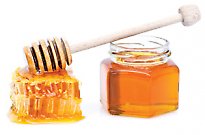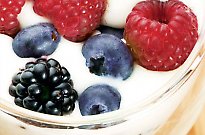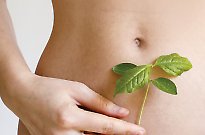
Fructose malabsorption

Susanna Nelson investigates the facts
We’ve all heard of peanut allergy, gluten allergy, lactose intolerance and wheat sensitivity, but what about fructose malabsorption? Susanna Nelson investigates
In the past 20 years, the science of food sensitivity has evolved considerably. Sufferers of what might previously have been disregarded as ‘a bit of wind’ or indigestion can now, with the help of experts, avoid the foods that might be causing discomfort. Each year, more is understood about the origins of food intolerance – and new dietary culprits are being exposed.
FRUCTOSE MALABSORPTION
We hear less about fructose malabsorption, a type of sugar sensitivity, than we do about lactose and gluten intolerance, but it affects a surprising proportion of the population. Fructose is the sugar found in plants and it naturally occurs in honey, tree and vine fruits, flowers, berries and most root vegetables – for example, sweet potato. It has also been developed from sugar cane, sugar beets and corn (as high fructose corn syrup) into a cheap commercial sweetener and additive to soft drinks and processed foods.
Although fructose has always been widely present in our food, it is now consumed in unprecedented quantities in the modern diet. There are theories that over-consumption of fructose in its processed forms can overwhelm the body’s ability to deal with it, leading to obesity, type 2 diabetes and other chronic illnesses. As well as these problems, which are related to excess fructose consumption, around 30 per cent of the population are unable to absorb normal levels of fructose completely.
Fructose malabsorption (as distinct from fructose intolerance, which is a rare and serious hereditary condition) can occur at any age, and is found in very young children as well as the elderly. In children it might be known as fruit juice diarrhoea. It affects males and females and all ethnicities.
Although the condition is not life threatening, some studies have also linked fructose malabsorption with mood disturbances and depression, and long-term effects include anaemia, poor skin, nails and hair and general ill health. Sugar cravings are often an indicator of the condition. Fructose malabsorption can also be confused with lactose intolerance and gluten intolerance because the symptoms are so similar, though the food triggers and diagnoses are different.
HOW DOES FRUCTOSE MALABSORPTION HAPPEN?
Fructose is a rapidly fermentable sugar and it is absorbed into the wall of the small intestine, where it is used for nutrition and energy. In the case of malabsorption, the fructose cannot be absorbed in this way and requires glucose to be present in equal amounts in order to be absorbed. If glucose is not present, the fructose will travel down to the large intestine where bacteria will cause it to ferment, releasing the gases that cause symptoms similar to those of irritable bowel syndrome (IBS) – bloating, excess wind, abdominal distension or pain, diarrhoea or constipation.
“If someone is sensitive to fructose, I recommend that they modify their diet to restrict foods that contain more fructose in them than glucose. Foods that are in balance between fructose and glucose are fine, and foods that contain more glucose than fructose are fine,” says Dr Sue Shepherd, an advanced accredited practising dietician and leading expert on fructose malabsorption.
The test for fructose malabsorption is simple – a hydrogen breath test is used to detect the gases that indicate there is unabsorbed fructose in the large intestine. Although the condition is found in up to 30-to-40 per cent of the general population, it is only active, or symptomatic, in those who have IBS. “Fructose malabsorption can be a trigger for symptoms of irritable bowel syndrome,” says Dr Shepherd. “So in patients with IBS symptoms, we can look to see if fructose malabsorption is a potential cause.” It is estimated that around a third of IBS cases are caused by fructose malabsorption.
CONTROLLING SYMPTOMS – THE LOW FODMAPS DIET
There is no cure for fructose malabsorption and dietary restriction is necessary to limit the symptoms. “Very little attention was paid to fructose malabsorption until the late 1990s in Melbourne, where some gastroenterologists started testing their IBS patients for fructose malabsorption,” says Dr Shepherd. “I was referred these patients, to teach them a diet for fructose malabsorption. However, there was no diet for fructose malabsorption.”
In 1999, Dr Shepherd created the Low FODMAP Diet, which helps sufferers to manage IBS, lactose intolerance and fructose malabsorption. FODMAP is an acronym that stands for Fermentable Oligo-, Di- and Mono-saccharides and Polyols. In layperson’s terms, this covers a collection of poorly absorbed carbohydrates that contribute to IBS and fructose malabsorption. The diet is based on scientific research and is supported by medical professionals. It has been inaccurately reported as a weight loss diet, but it was not developed in order to aid weight loss.
The Low FODMAP Diet restricts fructose, fructans (a compound of fructose), lactose, polyols (sorbitol, mannitol, artificially sweetened gums and confectionery) and galacto-oligosaccharides (found in baked beans, kidney beans, lentils and chickpeas). “The diet involves limiting foods and drinks that contain FODMAPs, which are known to be triggers of symptoms of IBS,” Dr Shepherd says. “The Low FODMAP Diet does not exclude whole food groups, but encourages instead an intake of a comprehensive range of alternative foods that do not cause these symptoms.”
Dr Shepherd is herself a sufferer of coeliac disease. She was puzzled when people would complain of the symptoms of coeliac disease when they did not have the disease and became interested in finding out what the missing food sensitivity was. “I wanted to find out what else could be in wheat that would cause symptoms,” she says. “I also wanted to develop a diet for fructose malabsorption. I took these two aspects and they drove me to develop a complete dietary approach.”
Aspects of Dr Shepherd’s diet are outlined in her many books for people with food intolerances, though she does caution that food recommendations will vary according to the particular diagnosis for an individual.
Choose a healthy eating plan or browse more health-related articles. Don't forget to join our online community on Twitter and Facebook.
Photo credit: Thinkstock


